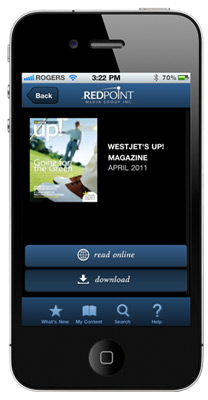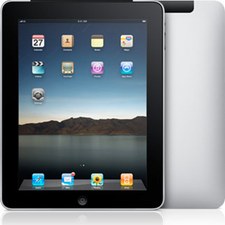|
Tuesday, June 28, 2011
New ProApp for the Apple App Store and Android Marketplace
Wednesday, June 22, 2011
System Update: Page Widgets, Annotations , Bookmaks & Notes
1) Page Widgets: Embed pretty much ANYTHING overlaying your pages
- Any external content like websites, videos or scripts can be embedded to overlay your pages
- From youtube videos, to facebook "like" buttons, to twitter feeds and linkedin shares, we've got some great widgets already built for you. You just need to set some fields to get these displaying right on your pages
- Choose the platform you want or don't want the widget to display. Don't show flash widgets on mobile devices which can't load flash OR target an advertisement widget to tablet users. You've got a lot of flexibilty with this tool.
- The only limitation is your imagination! You can start designing your publications with these widgets in mind.
- PageWidgetImage screenshot shows an embedded youtube video, a facebook like button, and a linked in share button
- PageWidgetOptions screenshot below shows the optional widgets you can add to your pages
PageWidgetOptions
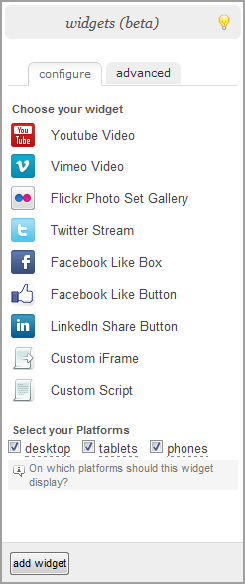
2) Annotations: Bookmarks and Sticky Notes
- If you are protecting your publication with subscription, remote authentication OR your publication is viewable on the mstand, users will be able to set page bookmarks and create notes that will show directly on the page.
- Once users login to their account, they can bookmark pages and make page notes that will always be displayed when they login!
- Great for remembering your place in a publication, or making notes/comments you can reference the next time you view
- Users just have click on the annotation tools at the top right(bookmarks) or bottom left (annotations) to create (see screenshot below)
3) Other upates and fixes
- New API method getAnnotations, for use in conjunction with the annotaions feature listed above (2)
- Master Accounts will be able to access newsstand settings if they need to for their sub-accounts...contact support to have this option enabled
- Various bug fixes and system improvements
Sunday, June 12, 2011
Designing Publications for Digital Platforms
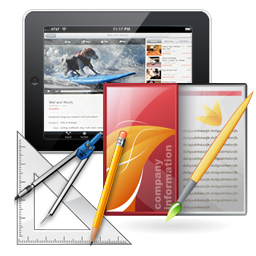
Before you hit upload and start sharing a digital edition with your audience, here are 5 things based on our customers feedback that you should consider when creating your content, including brochures, magazines, fliers, catalogs, textbooks…
- Mindset. When using mobile devices, for example, the mindset of a user is different from when he or she is sitting in front of a desktop or laptop. Quick access to desired information is more important than interactivity or relaxed entertainment. The nature of the device - a small screen, typically with touch capabilities - forms a natural frame around what content is useful and how to best present it.
- Screen size. Obviously, the screen size of any device dictates how information can be presented in the best way. Digital delivery needs to take into account the entire array from 40-inch desktop displays to 3-inch smartphone screens. Increase image and font size, clean up pages. Considering the screen size (e.g. 3 inches for a smartphone screen) try to increase the font size to at least 14pts. Also, let the pages breathe. Clean them up, less is more.
- Rich media and interactivity. When you add video to your content, the time spent with your brand by your audience will double. Best practice is to add 1-2 multimedia elements (sounds, video, flash) per page. Links to internal and external pages can also be included. Design keeping in mind that you’ll be integrating those elements (insert buttons boxes for links, rectangles for videos, etc).
- Navigation. When it comes to mobile devices, touch- or button-navigation has a huge impact on how digital content is and can be consumed on smartphones. However, users will still have a natural page-flipping reading experience.
- Educate readers. We’re all on the same boat. Not only publishers and content creators are learning how to communicate their message on these new platforms. Readers must also me educated on how to take advantage of the different tools - including navigation options (zoom, text-only mode, gestures) and enhancements. Proemags Mobile Enhanced ‘welcome pop-up screen’ is great to give users a bit of orientation before the dive into the digital edition.
Wednesday, April 13, 2011
PROemags "Enhanced Mobile" has arrived!!
Digital Publishing for Mobile
Characteristics
Platform independent
Free yourself from the shackles of the app stores. Our Mobile solution has all the power of a native app without any downloads. Every publication is instantly mobile-ready with no additional costs.Any device ready
Stay ahead of the curve with a solution geared for the present and future. Proemags Mobile is already capable of delivering a native app-like experience to today's leading devices, and will be able to instantly deliver the same to future devices.Small screen, big impression
With the mobile-friendly Proemags interface your readers can engage with your publications the same way as they do on larger screens and take advantage of touch-screen gestures such as swiping and pinching to navigate and zoom into pages.Tap, pinch and swipe
Tap or pinch to zoom. Use on-screen controls or swipe to flip pages, navigate via page links or website links, Proemags Mobile has a true native-app feel, all in the mobile browser.Built in subscription management
Utilize our built-in subscription management tools to have complete control over your sales process. Best of all, you keep all the revenues you generate.Text-only reading mode
Via the toolbar, access reading mode by pressing the "T" button on the toolbar. Proemags Mobile has all your bases covered.Video and Audio ready
On supported devices uploaded videos work seamlessly where you place them. Users have full control including play/pause and full-screen mode.Monday, January 31, 2011
Apple iPad Faces Risks from Android 3.0 Honeycomb
Apple CEO Steve Jobs famously denounced Android as unable to compete with the iPad, but Android 3.0 Honeycomb could raise tablet competition to a new level.
Apple CEO Steve Jobs famously (or infamously, depending on your point of view) lashed out against Google Android tablets during his company’s October earnings call, denouncing them as incapable of competing with the iPad.
The “painful lesson,” Jobs told analysts and media listening to that call, would come when competing tablet makers realized their tablets were too small, “abandoning developers and customers who jumped on the 7-inch bandwagon.”
And that was just one salvo. “I have a hard time imagining what those [competing] strategies are,” Jobs said, responding to an analyst’s question about rival tablets setting to challenge the iPad throughout 2011. “We think Android is very, very fragmented, and becoming more fragmented by the day.”
Welcome to Google’s counter-fire: Android 3.0, code-named “Honeycomb,” which the search-engine giant will preview for media Feb. 2 at its Mountain View, Calif. headquarters.
Honeycomb has been designed with larger screens in mind, including a retooled, tablet-friendly virtual keyboard and a brand-new system bar along the bottom of the screen. Google has also tinkered with the Web browser, which now offers tabbed browsing for multiple Web windows, and support for 3D graphics.
The most important differentiator between Honeycomb and its Android predecessors, though, may be the optimization for apps running on larger screens. Google executives had roundly stated the previous version, Android 2.2, was meant for smartphone-sized screens, a fact that didn’t seem to stop a variety of manufacturers from porting the software onto their full-sized tablets.
Such features, of course, seem designed with an eye toward combating Apple’s iOS on its own terms. Certainly, the ability to run apps on a 7-inch or 9-inch screen will boost the potential for Google’s Apps Marketplace, which despite an extensive library—hundreds of thousands of apps, and counting—has never adopted the cachet of Apple’s App Store.
Honeycomb could help accelerate the non-iPad tablet market in 2011. According to Raymond James analyst Brian Alexander, devices such as Motorola’s Xoom could ship as many as 1 million units in the first quarter of the year, driven in large part by improvements related to Honeycomb.
Research firm IDC also expects a rapid acceleration in tablet growth throughout early 2011, powered not only by Android, but also devices such as Research In Motion’s Playbook. “New product and service introductions, channel expansion, price competition and experimentation with new-use cases among consumers and enterprises” will all combine to propel the market forward, according to Susan Kevorkian, IDC’s research director of mobile-connected devices.
A more robust Android for tablets could also help drive enterprise adoption, particularly if the larger enterprise-software companies—i.e., SAP, Salesforce.com, Oracle, IBM and Microsoft—launch programs to support the platform. Although the iPad has made great strides in the enterprise, thanks to the added features of iOS 4.2 such as wireless printing and greater security, Android-based tablets generally make a strong showing in employee surveys of their most-coveted devices, and a more robust platform could build its appeal among IT administrators and procurers.
In other words, Android seems angling to give the iPad much more of a fight.
Apple CEO Steve Jobs famously (or infamously, depending on your point of view) lashed out against Google Android tablets during his company’s October earnings call, denouncing them as incapable of competing with the iPad.
The “painful lesson,” Jobs told analysts and media listening to that call, would come when competing tablet makers realized their tablets were too small, “abandoning developers and customers who jumped on the 7-inch bandwagon.”
And that was just one salvo. “I have a hard time imagining what those [competing] strategies are,” Jobs said, responding to an analyst’s question about rival tablets setting to challenge the iPad throughout 2011. “We think Android is very, very fragmented, and becoming more fragmented by the day.”
Welcome to Google’s counter-fire: Android 3.0, code-named “Honeycomb,” which the search-engine giant will preview for media Feb. 2 at its Mountain View, Calif. headquarters.
Honeycomb has been designed with larger screens in mind, including a retooled, tablet-friendly virtual keyboard and a brand-new system bar along the bottom of the screen. Google has also tinkered with the Web browser, which now offers tabbed browsing for multiple Web windows, and support for 3D graphics.
The most important differentiator between Honeycomb and its Android predecessors, though, may be the optimization for apps running on larger screens. Google executives had roundly stated the previous version, Android 2.2, was meant for smartphone-sized screens, a fact that didn’t seem to stop a variety of manufacturers from porting the software onto their full-sized tablets.
Such features, of course, seem designed with an eye toward combating Apple’s iOS on its own terms. Certainly, the ability to run apps on a 7-inch or 9-inch screen will boost the potential for Google’s Apps Marketplace, which despite an extensive library—hundreds of thousands of apps, and counting—has never adopted the cachet of Apple’s App Store.
Honeycomb could help accelerate the non-iPad tablet market in 2011. According to Raymond James analyst Brian Alexander, devices such as Motorola’s Xoom could ship as many as 1 million units in the first quarter of the year, driven in large part by improvements related to Honeycomb.
Research firm IDC also expects a rapid acceleration in tablet growth throughout early 2011, powered not only by Android, but also devices such as Research In Motion’s Playbook. “New product and service introductions, channel expansion, price competition and experimentation with new-use cases among consumers and enterprises” will all combine to propel the market forward, according to Susan Kevorkian, IDC’s research director of mobile-connected devices.
A more robust Android for tablets could also help drive enterprise adoption, particularly if the larger enterprise-software companies—i.e., SAP, Salesforce.com, Oracle, IBM and Microsoft—launch programs to support the platform. Although the iPad has made great strides in the enterprise, thanks to the added features of iOS 4.2 such as wireless printing and greater security, Android-based tablets generally make a strong showing in employee surveys of their most-coveted devices, and a more robust platform could build its appeal among IT administrators and procurers.
In other words, Android seems angling to give the iPad much more of a fight.
Wednesday, January 19, 2011
Don't think Mobile matters ? iPad Drives Tablet Market to 17 Million Units Shipped in 2010
What kind of impact has Apple’s iPad had on the tablet market? In just one quarter, the iPad helped drive up sales of media tablets by 45% and took nearly 90% of the market.
A new report from IDC shows that both the media tablet market and the e-reader market made big leaps in 2010. The market for media tablets grew from 3.3 million in Q2 to 4.8 million in Q3, an increase of 45.1%. That growth was fueled almost exclusively by the iPad. In Q3, Apple sold 4.19 million iPads, representing over 87% of the media tablet market.
IDC defines media tablets as devices larger than five inches and less than 14 inches running “lightweight operating systems,” primarily iOS and Android (Android).
E-readers experienced rapid growth as well, led by the Amazon Kindle. 1.14 million Kindles were shipped in Q3, representing 41.5% of the e-reader market. Unexpectedly though, the Pandigital Novel (440 million) beat out the Barnes and Noble Nook (420 million) for second place.
The most interesting part of the report though was the overall forecasts for 2010, 2011 and 2012. For 2010, IDC predicts that about 17 million media tablets will be shipped (they’re still counting up the numbers), but that it will grow to a whopping 44.6 million in 2011 and 70.8 million in 2012. If devices like the iPad 2 and the Motorola Xoom succeed though, then IDC might have to revise its numbers.
Will Apple be able to sustain its massive lead in the tablet market, or will Android start eating into that market share? We’re going to find out soon.
A new report from IDC shows that both the media tablet market and the e-reader market made big leaps in 2010. The market for media tablets grew from 3.3 million in Q2 to 4.8 million in Q3, an increase of 45.1%. That growth was fueled almost exclusively by the iPad. In Q3, Apple sold 4.19 million iPads, representing over 87% of the media tablet market.
IDC defines media tablets as devices larger than five inches and less than 14 inches running “lightweight operating systems,” primarily iOS and Android (Android).
E-readers experienced rapid growth as well, led by the Amazon Kindle. 1.14 million Kindles were shipped in Q3, representing 41.5% of the e-reader market. Unexpectedly though, the Pandigital Novel (440 million) beat out the Barnes and Noble Nook (420 million) for second place.
The most interesting part of the report though was the overall forecasts for 2010, 2011 and 2012. For 2010, IDC predicts that about 17 million media tablets will be shipped (they’re still counting up the numbers), but that it will grow to a whopping 44.6 million in 2011 and 70.8 million in 2012. If devices like the iPad 2 and the Motorola Xoom succeed though, then IDC might have to revise its numbers.
Will Apple be able to sustain its massive lead in the tablet market, or will Android start eating into that market share? We’re going to find out soon.
Saturday, January 8, 2011
CES 2011: Seven tablets you should know about
Here is the seven most exciting tablet computers coming out of CES that we think you should know about (in no particular order). You may see a common theme here -- many of them run on Android, which means 2011 could very well also be the year Android breaks out of its primarily phone-based shell.
1. Dell Streak 7
Dell's first entrant into the 4G world is its Dell Streak 7 tablet, which will come to T-Mobile USA's network later this year. The device includes a 7-inch screen and a dual core processor. The negative here would be the fact that it will run Android 2.2 out of the box, however Dell said it would be upgradable to Android 3.0 "Honeycomb" when that releases later this year.
A 10-inch version is also on its way, and was briefly shown by the company at the show.

2. Toshiba "Tegra 2"
Although Toshiba's tablet hasn't exactly been named yet, the device would run on NVidia's Tegra chip technology. While the demo device shown to CES attendees is running Android 2.2, it should ship with Android 3.0. It's a little bigger than the streak with a 10-inch screen.
A cool feature with this tablet is the technology included called "Resolution Plus." Just like modern DVD players, the standard definition video is upconverted to appear as high definition. It will also include front and rear facing cameras, as well as Mini USB, USB, HDMI, and microSD card slots.
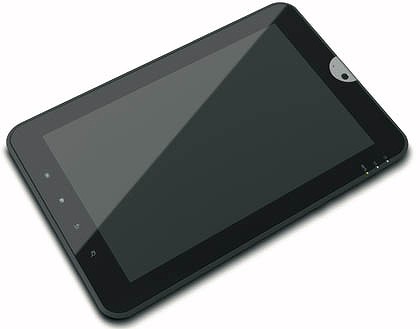
3. Motorola Xoom
Our own Tim Conneally got to take a look at this planned tablet, although it was only a shell. Regardless, we got some early word on the specs: Android 3.0, dual-core 1GHz processor, front and rear-facing cameras, HDMI, and data support from Verizon Wireless when it releases later this quarter.
For those wishing to take advantage of Verizon's 4G LTE network, an attachment would be offered in the second quarter of this year. See this video from Tim for a little bit more on the Xoom.
4. RIM PlayBook
We've covered the PlayBook at length here, from being the first to actually confirm the true specs of the device back in July to its official unveiling in September. RIM is using the platform of CES to further build hype for its product, and we now know the company is moving up its launch goals to this quarter, a quarter earlier than expected.
Charles Arthur of The Guardian spoke with RIM's John Wong about the device:
5. Lenovo IdeaPad U1/LePad
Lenovo's entrant is somewhat interesting, because at first it really is not a tablet. It starts out as a 10.1-inch netbook running Windows 7. However, when detached it becomes the "LePad," running Android 2.2.
The computer's shell is almost like a case of sorts, and the screen is the tablet part that detaches out. Lenovo actually showed a similar product last year, however at that time they had planned to use a proprietary operating system developed in-house.
Now, the tablet portion can be purchased separately, giving the "LePad" portion a competitive $500 price point. Add the case that makes it a laptop, and the price shoots up to $1,300.
Erin Malinowski of Wired explains how it works:
6. Vizio Via
Thought Vizio just made HDTV's? Think again. The company is one of the many trying to make a splash at CES with its Via tablet. Like many of its new competitors, it is also running Android and sports an 8-inch screen. Those that have seen it up close say the sharpness beats that of the iPad: this could be explained by the fact that the iPad's screen is almost two inches larger.
Initial models of the device will include 802.11n and Bluetooth connectivity, although it would have the capability down the road to support cellular data, the company says. Mini-HDMI is supported, and not surprisingly the device includes IR support so you can use it as a remote control.
(We should note that Vizio also debuted an Android phone at the show as well. Here's hoping the phone and tablet are as budget-minded as their HDTVs are known to be!)
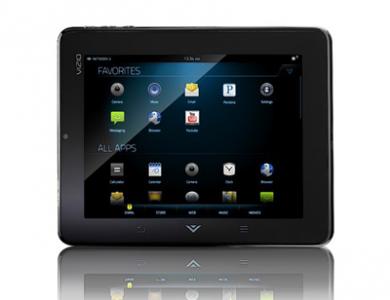
7. NEC LT-W
NEC's entrant, the LT-W, breaks the single screen mold of the traditional tablet, although from what the company is saying, is still a long ways off. Launch in Japan isn't expected for another six months, and the company has yet to specify if and when it would be launched internationally -- likely in any case wouldn't even bear the NEC brand (the company licenses its work to others).
Either way, the dual screen tablet opens like a book, which leads me to believe that this device may have a future as an e-reading device of sorts. Unfortunately, it uses resistive technology for the touch screen functionality, which means the display may not be as sensitive as some tablet users may have come to expect.
With its bulky industrial look and seemingly less consumer appeal, this type of tablet may see more commercial applications. NEC isn't sure either -- the company plans to make it available for partners and see where it goes from there. Thus, maybe the company is just trying to make its mark in a tech sector where everyone seems to be these days.
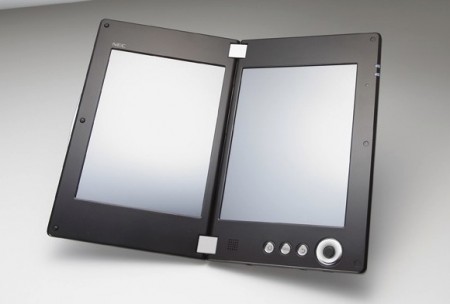
This is just a partial list -- believe us -- of the tablets floating around CES 2011. We'd be interested in hearing what other tablets you've seen out there at the yearly confab that have caught your eye.
1. Dell Streak 7
Dell's first entrant into the 4G world is its Dell Streak 7 tablet, which will come to T-Mobile USA's network later this year. The device includes a 7-inch screen and a dual core processor. The negative here would be the fact that it will run Android 2.2 out of the box, however Dell said it would be upgradable to Android 3.0 "Honeycomb" when that releases later this year.
A 10-inch version is also on its way, and was briefly shown by the company at the show.

2. Toshiba "Tegra 2"
Although Toshiba's tablet hasn't exactly been named yet, the device would run on NVidia's Tegra chip technology. While the demo device shown to CES attendees is running Android 2.2, it should ship with Android 3.0. It's a little bigger than the streak with a 10-inch screen.
A cool feature with this tablet is the technology included called "Resolution Plus." Just like modern DVD players, the standard definition video is upconverted to appear as high definition. It will also include front and rear facing cameras, as well as Mini USB, USB, HDMI, and microSD card slots.

3. Motorola Xoom
Our own Tim Conneally got to take a look at this planned tablet, although it was only a shell. Regardless, we got some early word on the specs: Android 3.0, dual-core 1GHz processor, front and rear-facing cameras, HDMI, and data support from Verizon Wireless when it releases later this quarter.
For those wishing to take advantage of Verizon's 4G LTE network, an attachment would be offered in the second quarter of this year. See this video from Tim for a little bit more on the Xoom.
4. RIM PlayBook
We've covered the PlayBook at length here, from being the first to actually confirm the true specs of the device back in July to its official unveiling in September. RIM is using the platform of CES to further build hype for its product, and we now know the company is moving up its launch goals to this quarter, a quarter earlier than expected.
Charles Arthur of The Guardian spoke with RIM's John Wong about the device:
5. Lenovo IdeaPad U1/LePad
Lenovo's entrant is somewhat interesting, because at first it really is not a tablet. It starts out as a 10.1-inch netbook running Windows 7. However, when detached it becomes the "LePad," running Android 2.2.
The computer's shell is almost like a case of sorts, and the screen is the tablet part that detaches out. Lenovo actually showed a similar product last year, however at that time they had planned to use a proprietary operating system developed in-house.
Now, the tablet portion can be purchased separately, giving the "LePad" portion a competitive $500 price point. Add the case that makes it a laptop, and the price shoots up to $1,300.
Erin Malinowski of Wired explains how it works:
6. Vizio Via
Thought Vizio just made HDTV's? Think again. The company is one of the many trying to make a splash at CES with its Via tablet. Like many of its new competitors, it is also running Android and sports an 8-inch screen. Those that have seen it up close say the sharpness beats that of the iPad: this could be explained by the fact that the iPad's screen is almost two inches larger.
Initial models of the device will include 802.11n and Bluetooth connectivity, although it would have the capability down the road to support cellular data, the company says. Mini-HDMI is supported, and not surprisingly the device includes IR support so you can use it as a remote control.
(We should note that Vizio also debuted an Android phone at the show as well. Here's hoping the phone and tablet are as budget-minded as their HDTVs are known to be!)

7. NEC LT-W
NEC's entrant, the LT-W, breaks the single screen mold of the traditional tablet, although from what the company is saying, is still a long ways off. Launch in Japan isn't expected for another six months, and the company has yet to specify if and when it would be launched internationally -- likely in any case wouldn't even bear the NEC brand (the company licenses its work to others).
Either way, the dual screen tablet opens like a book, which leads me to believe that this device may have a future as an e-reading device of sorts. Unfortunately, it uses resistive technology for the touch screen functionality, which means the display may not be as sensitive as some tablet users may have come to expect.
With its bulky industrial look and seemingly less consumer appeal, this type of tablet may see more commercial applications. NEC isn't sure either -- the company plans to make it available for partners and see where it goes from there. Thus, maybe the company is just trying to make its mark in a tech sector where everyone seems to be these days.

This is just a partial list -- believe us -- of the tablets floating around CES 2011. We'd be interested in hearing what other tablets you've seen out there at the yearly confab that have caught your eye.


